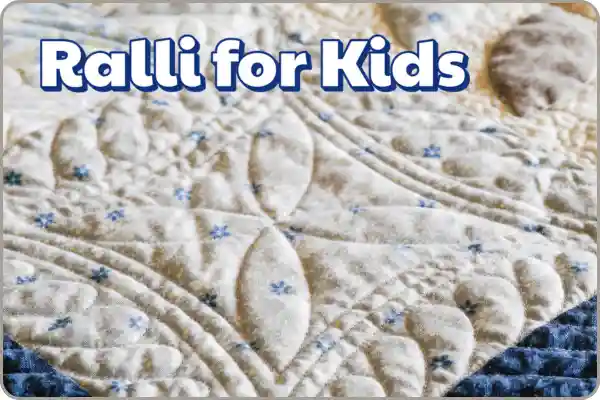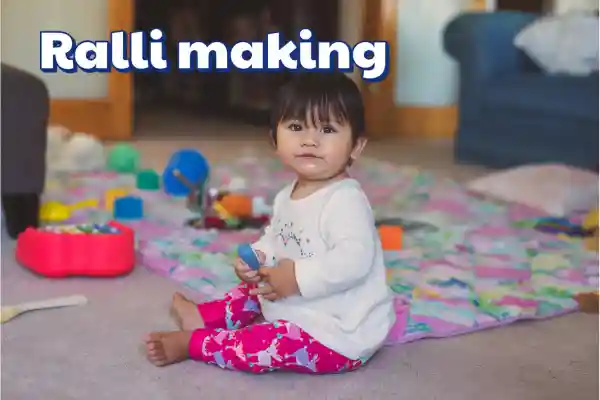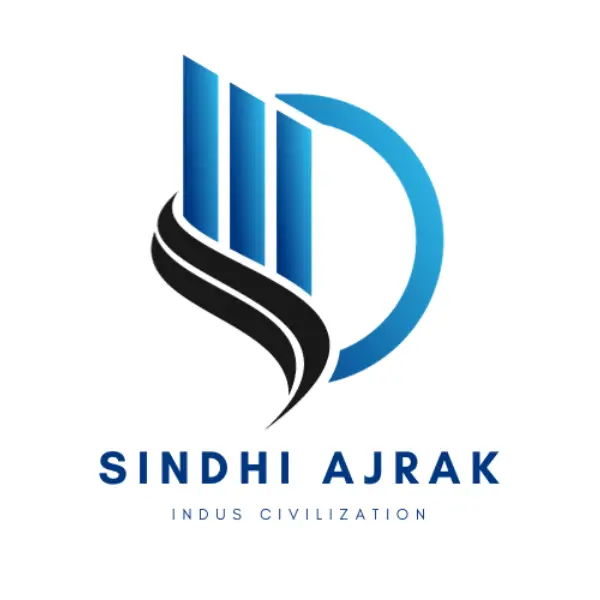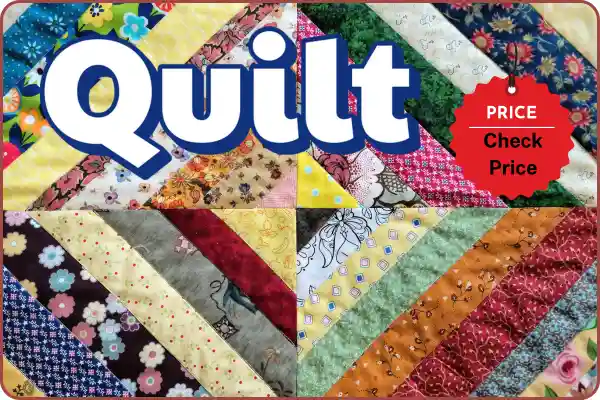Ralli, the craftsmanship of Indus People
In Sindh, every home has a special thing called a Ralli — in Sindhi “رَلِّي”. Known in English as a quilt, the Ralli is more than just a blanket. It is a beautifully quilted piece of art, deeply rooted in the thousand-year-old heritage of the Indus Civilization. Handcrafted by Sindhi female quilters using unique quilt patterns.
Each Rali reflects our daily life, culture, and traditions. Passed down through generations, this quilted treasure tells stories of love, skill, and identity. It’s not just used for warmth, but cherished as a symbol of Sindh’s vibrant and enduring cultural legacy. More than just a blanket, Ralli is often layered, with a beautifully stitched quilt cover on top.
This cover not only protects the inner layers but also showcases the artistry of skilled women quilters. Decorated with unique quilt patterns, the cover reflects generations of cultural expression. Each Relli tells quilt story—stitched with care, tradition, and identity—making it an essential part of daily life, ceremonies, and the timeless legacy of Sindh’s rich craftsmanship.
People in other countries mostly use bedsheets and blankets. But in Sindh, we use Rali every day. It is soft, layered, and very comfortable. It fits perfectly on our wooden cots and brings warmth and beauty to our homes.
Old Craft from Indus Valley Times
The history of Ralli goes back to the time of the Indus Valley Civilization. Even today, we use the same style of stitching and quitl patterns that were used thousands of years ago. Making a Rili or quilting is not only a daily need but also a way to keep our old traditions alive.
A small quilt known as “raliko” is traditionally made by females for newborn babies in some cultures. It serves a pamper-like function, providing comfort and warmth to the infant. This quilt is often designed with soft quilting fabric and is highly cherished by the family.
The raliko is used for a certain period until it gets spoiled due to frequent use, after which it is washed and replaced. Its role is vital in ensuring the baby’s comfort while also symbolizing the care and love extended to the newborn by the family, especially the women who craft it.
Made by Women with Love and Skill
Quilting is a skill passed from mothers to daughters. Girls learn to stitch small pieces of cloth together to make beautiful patterns. Many Rallies are made using old clothes, which saves money and reduces waste. These are often given as gifts during weddings or special family events.
Making Reli is also a way for many women to earn money. They sell their Ralis on quilty Shop in markets and online. This helps them support their families and use their talent for a good cause.Part of Every Home in Sindh
Queen size Ralli
Reli, traditionally used on cots, are also crafted in queen size. These handmade quilts queen size maintain intricate patterns and vibrant colors, offering both cultural heritage and comfort, making them perfect for larger beds.
Quilts for kids
Small Rallis are made for children of all ages, from newborns to teenagers. These ralika are designed with age-appropriate patterns, providing warmth and comfort. For newborns, simpler designs are used, while older children and teenagers enjoy more intricate patterns and vibrant colors, reflecting the rich cultural heritage of Sindh.

Useful, Beautiful, and Full of Memories
These are not just useful. They also hold memories. A Ralli may be made from the clothes of a loved one. Each piece of cloth tells a story. Some families keep their Rallis for many years and pass them on to the next generation.
Keeping the Rilli Tradition Alive
Quilting is more than just a craft in Pakistan—it is a living tradition, deeply woven into the quilt fabric of our daily lives. While modern technology has replaced many traditional handcrafts, the humble quilt, especially in Sindh, has managed to survive and thrive—not in museums or exhibitions, but in our homes.
Whether in the remote villages of interior Sindh or the bustling cities from Karachi to Sukkur, these are not only cherished but actively used. In villages, particularly during the summer months, people often do not use any additional bedsheets. Instead, rillis for beds serve both as a covering and as an underlayer while sleeping.
This might sound surprising to outsiders, but the comfort and cooling effect of hand-stitched rili make them perfect even in hot weather. Unlike synthetic materials, the natural cotton filling in traditional quilts allows air to pass through, providing a cooling sensation and making it suitable for all seasons.
Cities have adopted this tradition as well. Despite modern bedding alternatives, many urban households still prefer using handmade quilts without using quilting machines, especially those crafted with traditional Sindhi patterns. These patterns—often colorful, geometrical, and symbolic—tell stories of the land and the people.
Each stitch represents the hard work, creativity, and love of the women who make them. These aren’t just functional items; they are pieces of heritage that reflect our cultural identity. Unfortunately, while the usage of quilts is widespread, there is little to no institutional recognition of this craft.
Unlike countries like the United States, which proudly hosts the International Quilt Museum showcasing quilting from across the globe, Pakistan lacks such museums or cultural centers dedicated to preserving and promoting its quilting heritage. Our government has yet to take significant steps to protect or highlight this beautiful form of craftsmanship.
Despite this neglect, the spirit of quilting lives on. In nearly every city of Sindh—from the large metropolitan Karachi to smaller cities like Sukkur—you will find quilt shops operating and serving a loyal customer base. Some shops even specialize in wedding quilts, baby quilts, and traditional Sindhi designs passed down through generations.
Women in rural areas still make quilts by hand, often using old clothes and recycled fabrics, making each piece unique and environmentally friendly. What makes this even more special is that the art has survived not through policy or funding, but through the love and loyalty of the people.

It is a silent protest against cultural erasure—a way for communities to keep their traditions alive on their own terms.
In conclusion, while Pakistan may not have a quilt museum or official preservation projects, the legacy of quilts lives strong in our homes. It is used daily, valued for both comfort and cultural connection.
It is time we recognize this as more than a household item—it is a heritage that deserves to be showcased, celebrated, and preserved for future generations.
Final Words – Ralli Means Home
Quilts in Sindh symbolize a rich cultural legacy, sustained by everyday use rather than formal recognition. From rural homes to city dwellings, their continued presence showcases the resilience of Sindhi tradition, with each handmade piece reflecting the region’s deep-rooted identity and artistic heritage.
In Sindh, quilts are commonly known as **Ralli**, though spellings may vary such as *Rali*, *Reli*, *Rili*, *Rallis*, or *Ralis*. Despite the variations in name, they all refer to the same traditional handmade quilt. Ralli-making is a time-honored craft passed down through generations, with each piece showcasing vibrant patterns and intricate stitching unique to Sindhi culture.
سنڌ ۾ رليون رڳو بسترا نه، پر هڪ جيئري تهذيب آهن. حڪومت جي بي ڌياني ۽ ميوزيم جي کوٽ باوجود، ڳوٺن کان شهرن تائين روزاني استعمال هيءَ روايت زنده رکي آهي. سنڌي هنر، ثقافت ۽ سڃاڻپ هر سلائي ۾ جهلڪندي آهي.

